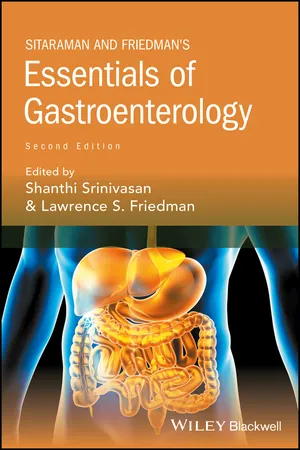
Sitaraman and Friedman's Essentials of Gastroenterology
- English
- ePUB (mobile friendly)
- Available on iOS & Android
Sitaraman and Friedman's Essentials of Gastroenterology
About this book
This revised and updated second edition of the popular and comprehensive guide to the study of gastroenterology
The revised second edition of Essentials of Gastroenterology provides a highly practical and concise guide to gastroenterology. The text covers every major disorder likely to be encountered during both GI training and in clinical practice. It also offers a handbook for preparing for Board examinations (e.g., USMLE and Internal Medicine Board examinations) as well as a handy clinical consultation tool. Fully updated to reflect the latest scientific information and practice guidelines, each section of the book covers a specific area of the gastroenterology tract and follows a standard outline: general information, normal physiology, etiology and pathophysiology, clinical presentation, diagnosis, differential diagnosis, complications, prognosis, and treatment.
The text provides easy-to-assimilate information on each disorder and includes the key facts, concise, bulleted paragraphs, and a structure that lends itself to accessibility and point-of-care use in a busy clinical setting. In addition, Internal Medicine Board-style multiple choice questions allow users to self-assess their knowledge, a photo gallery provides a great visual element, and clinical cases throughout allow readers to identify with real-life clinical scenarios. Essentials of Gastroenterology is the hands-on guide that:
• Covers the whole of gastroenterology in one highly practical volume
• Presents updated pedagogic features to help achieve rapid clinical understanding, such as case studies, practice points, key weblinks and potential pitfalls boxes
• Includes more than 100 Internal Medicine Board-style multiple choice questions ideal for self-assessment
• Contains comparison of major society (BSG, ASG, ACG, UEGF, etc.) guidelines for all main GI conditions
Designed for us by gastroenterologists and GI trainees, Essentials of Gastroenterology is therevised and improved edition of the popular manual that is filled with up-to-date information on all the GI disorders. Trainees will learn the essentials of their specialty, as well as providing the seasoned gastroenterologist with a useful refresher tool.
Frequently asked questions
- Essential is ideal for learners and professionals who enjoy exploring a wide range of subjects. Access the Essential Library with 800,000+ trusted titles and best-sellers across business, personal growth, and the humanities. Includes unlimited reading time and Standard Read Aloud voice.
- Complete: Perfect for advanced learners and researchers needing full, unrestricted access. Unlock 1.4M+ books across hundreds of subjects, including academic and specialized titles. The Complete Plan also includes advanced features like Premium Read Aloud and Research Assistant.
Please note we cannot support devices running on iOS 13 and Android 7 or earlier. Learn more about using the app.
Information
Luminal Gastrointestinal Tract
1
Gastroesophageal Reflux Disease
Clinical Vignette
General
- Gastroesophageal reflux disease (GERD) is defined as symptoms or tissue damage caused by the reflux of gastric contents into the esophagus.
- GERD is a common disorder, affecting almost half of the US population, with varying severity. Some 40% of the US population experiences reflux symptoms about once per month, 20% complain of symptoms once per week, and 7–10% report daily symptoms.
- GERD affects 10–20% of western populations. It is less common in Asian and African countries.
- It is estimated that GERD costs the US nearly $2 billion each week in lost productivity.
Risk Factors
- Advancing age (>65 years)
- Obesity
- Genetic factors
- Alcohol use
- Pregnancy
- Smoking
Spectrum of GERD
- The clinical spectrum of GERD ranges from nonerosive reflux disease (NERD) to erosive esophagitis (Figure 1.1). NERD is defined as symptoms of acid reflux without evidence of esophageal damage, such as mucosal erosions or breaks on esophagogastroduodenoscopy (EGD) in patients who are not on acid‐suppressive therapy.
- A small proportion of patients will develop metaplasia of the squamous esophageal epithelium to columnar epithelium (Barrett’s esophagus). Barrett’s esophagus is a risk factor for adenocarcinoma.
- Some patients who present with heartburn have ‘functional’ heartburn. This is defined as a burning retrosternal discomfort in the absence of gastroesophageal reflux or an esophageal motor disorder. Ambulatory pH testing may be useful to differentiate NERD from functional heartburn.

Pathophysiology
- Transient lower esophageal sphincter relaxations (TLESRs):
- The etiology of GERD is multifactorial; however, ‘aberrant’ TLESRs are the major pathophysiologic factors in many patients with GERD.
- A TLESR is defined as relaxation of the lower esophageal sphincter in response to gastric distension. In healthy persons, TLESRs occur in the absence of a swallow, last 10–30 seconds, and result in physiologic gastroesophageal reflux.
- TLESRs are regulated by the neurotransmitter γ‐aminobutyric acid (GABA) acting on GABA type B receptors located in the peripheral nervous system, as well as in the brainstem.
- In many cases, GERD is thought to be caused by an increased number or a prolonged duration of TLESRs.
- Gastric factors:
- Increased gastric acid production as well as delayed gastric emptying with distention may trigger TLESRs.
- Diminished esophageal clearance:
- Poor esophageal clearance due to defects in primary or secondary esophageal peristalsis allows prolonged exposure of the esophageal mucosa to acid.
- Diet and medications:
- Dietary factors such as acidic foods, caffeine, alcohol, peppermint, and chocolate may reduce lower esophageal sphincter (LES) tone or increase gastric acid production.
- Medications such as calcium channel blockers, hormones (e.g., progesterone, cholecystokinins, secretin), beta‐adrenergic agonists (albuterol), nitrates, and barbiturates can decrease LES tone, thereby predi...
Table of contents
- Cover
- Title Page
- Table of Contents
- Contributor List
- Foreword
- Preface
- Acknowledgments
- Tribute to Shanthi V. Sitaraman
- Luminal Gastrointestinal Tract
- Liver
- Pancreas and Biliary System
- Common Problems in Gastroenterology
- Picture Gallery
- Index
- End User License Agreement